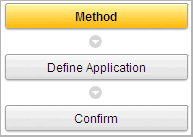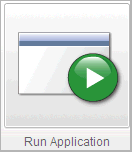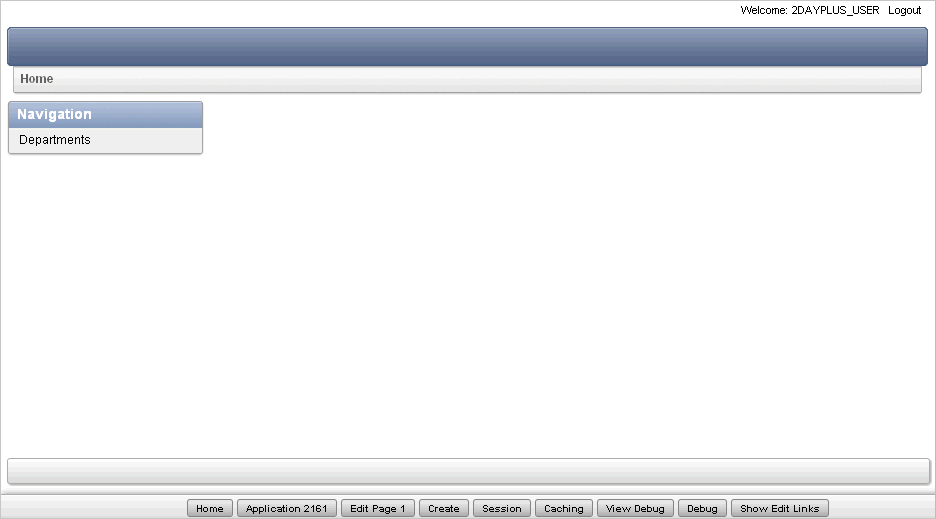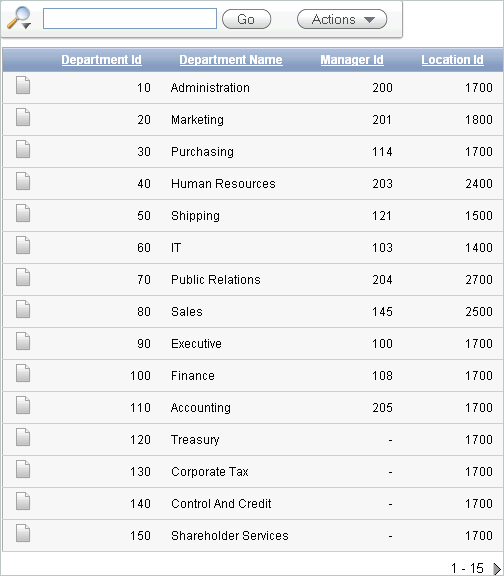
Previous

Next
Home > Building Your Application > Creating the Initial Applic...
 Previous |
 Next |
This first exercise guides you through creating your initial application. Using the Create Application Wizard, you create two pages and specify basic application functionality.
The pages created in this section include:
Home - This page is the first page displayed when the application is run. This page contains a link to the Departments report.
Departments - This page is an interactive report of all departments.
There are two types of reports, interactive and classic. Interactive is the default when creating applications, converting forms and creating report regions. Interactive reports should be selected when you want to provide user customizations such as filters, sorting, compilation and so on. If you have limited need for this functionality, you are best served by using a classic report.
To create your initial application:
Log in to Oracle Application Express.
For instructions, see "Logging In to the Hosted Demo Environment" or "Logging In to Your Local Instance".
On the Workspace home page, click Application Builder.
Click the Create button.
The Create Application Wizard appears.
Note that each page within a wizard displays the title of the wizard (for example, Create Application). Each wizard page also displays a series of blocks on the left, representing the sequence of steps. The highlighted block indicates the step you are performing.

To orient you, each step in these exercises generally begin with the block label. For example, the first step in the Create Application Wizard highlights the word Method. Therefore, the next step orients you by beginning with the words For Method.
For Method, select Database and click Next.
Accept the default, From Scratch, and click Next.
For Name:
Name - Enter AnyCo Corp
Application - accept the default ID. The system provides a unique ID for each application you create in this workspace.
Create Application - Accept the default, From scratch.
Schema - Select the schema that contains the objects for this tutorial (for example, TWODAYPLUS).
Click Next.
Next, add a page to your application.
For Pages, specify the following in the Add Page section:
Select Page Type - Accept the default, Blank.
|
Tip: Explanatory information for each option appears on the right side of the page. This page-level help appears throughout the application. |
Page Name - Enter Home.
Click Add Page.
The Home page is now listed in the top area. Also, note that the Add Page area appears so you can continue adding pages to your initial application.
Next, add a report page on the OEHR_DEPARTMENTS table.
In the Add Page section, specify the following:
Select Page Type - Select Report.
Subordinate to Page - Select Home (1).
This sets up the hierarchy among the pages in your application.
Page Source - Accept the default, Table.
Table Name - Select OEHR_DEPARTMENTS.
The list shows all tables and views in the schema associated with the application.
Click Add Page.
Notice that the pages listed in the Create Application section reflect the hierarchy of the pages in your application.
Next, change the default page name, OEHR_DEPARTMENTS, to Departments.
Click the Oehr Departments link.
Under Page Definition, change the Page Name to Departments and click Apply Changes.
In the Create Application section, click Next.
Next, define some application-level settings.
For Tabs, select No Tabs and click Next.
For Shared Components, accept the default, No, and click Next.
For Attributes, make these changes:
Authentication Scheme - Accept the default, Application Express.
Note that Application Express is the default Authentication Scheme. The authentication scheme option enables you to control users' access to the application using Application Express authentication or another type of authentication.
Language - Accept the default, English (en)
User Language Preference Derived From - Accept the default, Use Application Primary Language.
Date Format - Click the up arrow and select 12-JAN-04.
Click Next.
For User Interface, select Theme 2 and click Next.
For Confirm, verify the information and click Create.
The two pages you created, Home and Departments, appear as icons by default.
|
Note: To view the pages in a report instead of as icons, click the View Report icon. Your view setting is retained from session to session.Because these steps use the default setting, switch back to Icons view before continuing. |
Notice that Oracle Application Express adds a Login page automatically to your application.

Congratulations! You created your first application using Oracle Application Express. Next, preview the application to see the application the way it would appear to end users.
You preview your application by running it. Running the application displays the rendered version of the application as end users would see it.
As you create pages, you can view them by running the page individually or by running the entire application. When you run a page or application, the Application Express engine dynamically renders it into viewable HTML based on data stored in the database.
To run the application, click the Run Application icon.

To run a specific page, click the Run Page icon.

To preview your application:
On the Application home page, click Run Application.
The first time you run an application you are prompted to enter a user name and password. To continue, simply enter your workspace user name and password and then click Login.
The first time you run an application you are prompted to enter a user name and password. To continue, simply enter your workspace user name and password and then click Login.
You can run the application using your Application Express login credentials because you chose Application Express Authentication when creating the application. For more information, see "Establishing User Identity Through Authentication" in Oracle Application Express Application Builder User's Guide.
The Home page of your application appears.

Notice that a link to the Departments page appears on the Home page because you set up that hierarchy.
Also notice the Developer toolbar at the bottom of the page. These links appear when you run an application within the development environment. The Developer toolbar offers a quick way to edit the current page, create a page, region, or page control, view session state, or toggle in and out of Debug mode.
Click the Departments link.
The Departments report appears.
